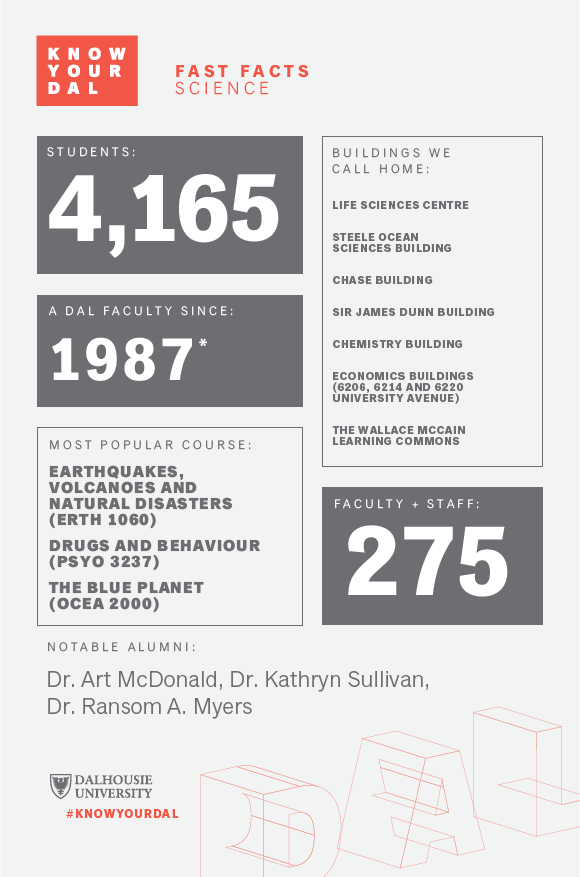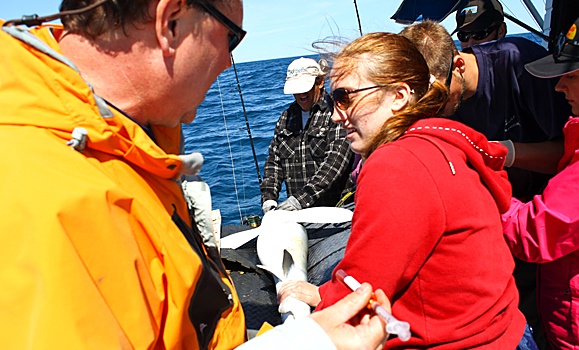In Dalhousie University’s early days, when it was called Dalhousie College, its first president Thomas McCulloch held subjects like mathematics and physics (known then as natural philosophy) in high regard.
Ever since, scientific disciplines have remained a constant in the long history of Dalhousie’s offerings. The Faculty has taken on a few different names and structures in that time, with today’s Faculty of Science (founded in 1987) stemming from the former Faculty of Arts and Science.
The Faculty of Science is Dal’s largest, with eight departments and over 3,700 undergraduate students and 470 graduate students. In Atlantic Canada, it’s a research powerhouse, conducting more than $26-million in research last year. We strive for excellence in teaching, providing hands-on fieldwork and research opportunities for students with options like the Department of Biology’s SEASIDE program and the Dalhousie Integrated Science Program for first-year students.
The Faculty is committed to making an impact beyond campus walls as well. Initiatives like Math Circles take our professors and student volunteers into classrooms across the province to show young students a side of math that standard curriculum may not cover. In addition, our departments work hard every year to host free lectures that make science accessible to the general public. Together, our students, faculty, staff and alumni show enthusiasm for the wonder of science and a passion to share their knowledge with the world.
But did you also know…

1. We have a greenhouse with a view
Our 6,500-square-foot greenhouse is an important space for undergraduate biology education at Dal. Perched atop the biology tower in the Life Sciences Centre, the eighth-floor greenhouse is home to hundreds of species of plants, which provide hands-on learning opportunities for students taking a variety of biology and ecology courses. When the Life Sciences Centre was constructed in the 1970s, a greenhouse on the roof of a structure was an innovative design feat.
2. 13 Nobel laureates have delivered public lectures about physics on campus
Every year since 1977 the Department of Physics and Atmospheric Sciences presents the E.W. Guptill Memorial Lecture, named after one of the department’s most influential professors and researchers. Known colloquially as the Guptill Lectures, they’re open to the public, usually held in October and always focus on the most cutting-edge physics research at the time. Over the years, 13 Nobel laureates have delivered Guptill Lectures at Dal. In fact, this year’s Nobel Prize Winner in Physics, Dal physics alumnus Dr. Art McDonald, returned to his alma matter to deliver the Guptill Lecture in 2005.
3. Our museum offers a glimpse of Nova Scotia’s natural history
 Thomas McCulloch was a Presbyterian minister originally from Scotland, who travelled to Nova Scotia in 1803. With a passion for education, he founded Pictou Academy and later became Dalhousie College’s first president in 1838. McCulloch saw the value of natural specimens in his teaching and began collecting plants, animals and minerals while exploring the wild areas of Nova Scotia. McCulloch’s collection of preserved birds from the 1800s was donated to the university after his death. Years later, Dal created the Thomas McCulloch Museum, a showcase of McCulloch’s specimens plus other collections donated to the university. The museum, located on the second floor of the Life Science Centre, is also home to fossils that are 500 million years old. Open to the public at no charge, the museum’s displays are available for viewing between 8:30 a.m. and 4:30 p.m. Mondays through Fridays.
Thomas McCulloch was a Presbyterian minister originally from Scotland, who travelled to Nova Scotia in 1803. With a passion for education, he founded Pictou Academy and later became Dalhousie College’s first president in 1838. McCulloch saw the value of natural specimens in his teaching and began collecting plants, animals and minerals while exploring the wild areas of Nova Scotia. McCulloch’s collection of preserved birds from the 1800s was donated to the university after his death. Years later, Dal created the Thomas McCulloch Museum, a showcase of McCulloch’s specimens plus other collections donated to the university. The museum, located on the second floor of the Life Science Centre, is also home to fossils that are 500 million years old. Open to the public at no charge, the museum’s displays are available for viewing between 8:30 a.m. and 4:30 p.m. Mondays through Fridays.
4. There’s a glassblowing shop in the Chemistry Building
 Tucked away in the Chemistry building, you may mistake the glassblowing shop for another teaching or research lab. But every day Todd Carter, Dal’s scientific glassblower, skillfully creates important (and delicate) scientific tools for researchers with specific needs. Following blueprints designed by researchers themselves, Carter produces what factory machines can’t. Research labs all across campus contain unique beakers, high vacuum lines and distillation systems created in Dal’s glassblowing shop, though anyone outside the Dal community with scientific glassware needs can benefit from the facility.
Tucked away in the Chemistry building, you may mistake the glassblowing shop for another teaching or research lab. But every day Todd Carter, Dal’s scientific glassblower, skillfully creates important (and delicate) scientific tools for researchers with specific needs. Following blueprints designed by researchers themselves, Carter produces what factory machines can’t. Research labs all across campus contain unique beakers, high vacuum lines and distillation systems created in Dal’s glassblowing shop, though anyone outside the Dal community with scientific glassware needs can benefit from the facility.
5. We like to show off our creative side, too
For the last 11 years, faculty, students, staff and alumni have submitted their impressive images for possible inclusion in the Faculty of Science’s annual Science As Art calendar. Each month compelling compositions, colours and textures explore different areas of science — from earth sciences to chemistry to biology. Past submissions include sunsets, insects, axon fibers, animal encounters, plasma globes and protoplasts. The calendar lands in almost 10,000 mailboxes this time each year, helping the Faculty of Science raise awareness of and funds for the Science Student Experience Fund.
Learn more about the Faculty of Science at its website.
 This article is part of "Know Your Dal," a 13-week series highlighting Dal's academic community. For more, including additional content from this week's profiled faculty, the Faculty of Science, visit dal.ca/knowyourdal.
This article is part of "Know Your Dal," a 13-week series highlighting Dal's academic community. For more, including additional content from this week's profiled faculty, the Faculty of Science, visit dal.ca/knowyourdal.


